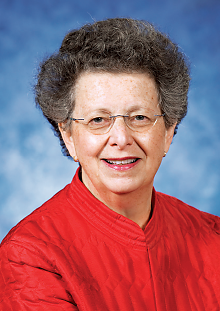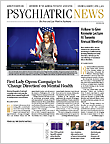Individuals born at extremely low birth weight and exposed to corticosteroids prior to birth may be at increased risk for psychopathology in their 30s, according to a report published online February 9 in Pediatrics.
A prospective, longitudinal comparison of extremely low birth weight (ELBW) survivors and normal birth weight (NBW) control participants found that ELBW survivors had a higher likelihood of developing a mental illness not related to substance abuse. More importantly, the subgroup of survivors whose mothers had received antenatal corticosteroids had an even higher risk in their 30s for mental illnesses.
“Preterm babies born before 34 weeks have a number of brain changes that predispose them to psychiatric problems later in life, even without exposure to steroids,” said lead author Ryan Van Lieshout, M.D., Ph.D., in an interview with Psychiatric News. “But steroids appear to act on the limbic system—especially the hippocampus—and those regions of the brain are involved in emotional regulation and cognition. So it could be that changes in those areas of the brain potentiated by steroid use account for what puts these individuals at higher risk later in life.”
But Van Lieshout, who is the Albert Einstein/Irving Zucker chair in neuroscience and an assistant professor in the Department of Psychiatry and Behavioral Neurosciences at Canada’s McMaster University, emphasized that the results are preliminary and require replication and that there are a great many areas ripe for research exploration to understand the apparent correlation between extremely low birth weight and/or maternal antenatal steroid use and psychiatric disorders later in life.
Van Lieshout did stress that corticosteroids for very tiny babies are frequently life saving and that the study results should not be construed as advising against their use.
A total of 397 mainly Caucasian infants born at 1,000 g from 1977 to 1982 in Ontario, Canada, were enrolled. Of these, 179 (45 percent) survived to hospital discharge and have been followed longitudinally, with assessments at ages 3, 5, 8, 14, 22 to 26, and 29 to 36.
At ages 29 to 36, 84 participated in a structured psychiatric interview.
Data on maternal antenatal corticosteroid exposure were collected from the medical charts of ELBW survivors at birth. A complete course of steroids was defined as a mother receiving two doses of betamethasone (12 mg) administered intramuscularly within a 24-hour period. The mothers of 24 ELBW participants received a complete course of steroids.
The NBW control group of 145 children born at 2,500 g has been assessed at ages 8, 14, 22 to 26, and 29 to 36. Of these, 90 completed the Mini-International Neuropsychiatric Interview between ages 29 and 36.
Van Lieshout and colleagues found that ELBW survivors had lower odds of an alcohol or substance use disorder but higher odds of current non-substance-related psychiatric problems. And those exposed to antenatal steroids had even higher odds of any current non-substance-related psychiatric disorders—particularly generalized anxiety disorder, the generalized type of social phobia, and the inattentive subtype of attention-deficit/hyperactivity disorder (ADHD).
Moreover, those ELBW individuals exposed to corticosteroids did not manifest the protective effect against substance abuse apparently conferred by small-for-gestational-age status.
(The diminished risk for substance abuse among individuals born at ELBW and small for gestational age has been shown previously and has been hypothesized to be a result of a cautious, risk-averse personality style, lower levels of externalizing behavior, and/or increased paternal oversight earlier in life.)
Van Lieshout and colleagues said the finding that ELBW survivors are more likely as adults to have a psychiatric disorder not related to substance abuse is in keeping with previous studies. “The etiologic factors contributing to this finding are complex and multifactorial, and they probably interact,” they suggested. “These factors include prenatal insults leading to preterm birth and exposure to stressful neonatal experiences, both of which could lead to brain changes and dysregulation of the hypothalamic-pituitary-adrenal axis.
“We are the first to report that not only are steroid-exposed ELBW survivors not protected against alcohol and substance use disorders, but they may have higher odds of developing generalized anxiety disorder, generalized social phobia, and the inattentive subtype of ADHD. Interestingly, these odds increased with increasing steroid exposure,” the researchers said.
Nada Stotland, M.D., a past president of APA and an expert on reproductive health, said the implications of the study are “fascinating” for future research on the relationship between birth weight and later mental illness. “The most promising aspects of this study are about the science,” she said. “There isn’t much to do with this clinically, except to say that we should be watching these individuals for depression and other mental illnesses.”
Stotland noted that babies born at extremely low birth weight are at risk for many complications, and clinicians and mothers should not reject steroid treatment because of a possible risk for psychiatric disorders much later in life. “Many of these babies don’t live, and they have serious complications of various kinds,” she said. “Mothers have no choice but to do what is best for the child who is born so tiny.”
Van Lieshout said replication of the findings with a much larger cohort—as might be done in Scandanavian or other countries with national birth registries—could help to better elucidate the correlations among birth weight, steroid use, and mental illness and/or substance abuse. “Additionally, looking at genetic markers and how they interact with birth weight would be illuminating,” he said.
“These individuals do have a higher risk in their 30s of having depression, anxiety, and ADHD,” he told Psychiatric News. “Importantly, though, the majority of ELBW babies don’t have any psychiatric problems at all. So it’s a risk factor.” ■
“Mental Health of Extremely Low Birth Weight Survivors in Their 30s” can be accessed
here.

